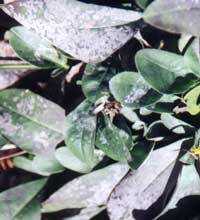Tips on how to use this section
The symptoms of the most common problems are in the left column of the chart. In the right column are the probably causes of those symptoms. For those problems for which there is detailed information in a different part of Yardener’s Helper, the name of the problem is linked to a detailed file. For those problems for which there are no additional files, the discussion is found in the paragraphs below the chart.
| Solving Coreopsis Problems | |
|---|---|
| Symptoms | Probable Cause |
| Leaves Curled and Distorted | Aphids |
| Leaves Mottled; Distorted | Aster Leafhoppers |
| Ragged Holes in Leaves | Slugs and Snails |
| Leaves Mottled; Flowers Malformed | Mosaic Virus |
| Leaves Coated White; Spotted or Blotched | Fungal Disease |
| Crowns and Roots Rot | Crown Rot |
| Flowers Discolored; Deformed | Aster Yellows |
| Leaves and Stems Eaten | Deer |
Leaves Mottled, Flowers Malformed from Mosaic Virus
The tobacco mosaic virus and other viruses are transmitted to coreopsis by aphids. The first symptom is usually a yellow spotty discoloration ("mottling" or "mosaic") of the leaves. Later the flowers are malformed. Eventually the plant dies.
There is no cure for plant viruses, so remove infected plants promptly. Virus outbreaks may be prevented by controlling aphids, keeping weeds down, and sterilizing tools used for cutting the flowers by dipping them in a solution of household bleach and water after use.
Leaves Coated White, Spotted or Blotched by Fungal Disease
 |
| Bob Lollo© |
| Powdery Mildew |
Powdery mildews thrive in both very humid or very dry weather. They are caused by fungi that live on the surface cells of the plant, not inside them. They cover leaves with a white or ash-gray powdery mold. Mildew rarely affects coreopsis until after the first flowering. Badly infected coreopsis leaves become discolored and distorted, then drop off.
Various leaf spots are also caused by fungi. These thrive on moist leaf surfaces and cause transparent to brown or black spots that disfigure the leaves. Some spots are surrounded by flecks or black dots, their spore-bearing fruiting bodies. They often join to form larger patches of dead tissue.
To deal with leaf fungus diseases pick off and discard severely infected leaves or cut back foliage all together if it is early in the season and the plant has time to regenerate. Prevent the spread of early infection to healthy leaves and nearby plants by spraying them with a general garden fungicide containing sulfur. Follow label instructions. Dig up and discard seriously infected plants together with the infected soil of the root ball. Mulch plants to discourage splash-borne infection. Remove dead plant debris promptly from the garden to reduce overwintering spore populations. For more information see the file Dealing With Fungal Disease
Crowns and Roots Rot Due to Crown Rot
Crown and root rot, caused by soil-dwelling bacteria and fungi, occasionally attack coreopsis. It is most likely to occur in a late winter thaw when dead leaves decompose on the ground and harbor bacteria and fungi which spread to healthy plants. Sometimes new shoots may fail to emerge in the spring. Other times the disease initially attacks a few spots on the crown of the plant where the roots join the stems at the soil line. Then it spreads to the entire crown, turning it into a malodorous mush. Fungi may invade next. If the plant is already in leaf, the lower leaves discolor and the young shoots begin to wilt. The roots are blackened, rotten and covered with white fungal threads. The whole plant dies in a few days.
Remove and discard infected plants and the soil of the rootball in the trash. Avoid replanting coreopsis in the same place for awhile. Thoroughly cultivate around the plants to encourage the soil to dry out, which retards fungus growth. Keep winter mulch away from plant crowns to reduce problems.
Flowers Discolored, Deformed Due to Aster Yellows
Aster yellows is caused by a mycoplasma-like organism, similar to bacteria. It is spread by leafhoppers and aphids. Coreopsis leaves and stems, or sometimes entire plants, may turn greenish-yellow, and be stunted or dwarfed. Leaves are often spindly. Flowers are discolored and may be dwarfed or aborted entirely. Plants may wilt and die early.
Remove and destroy infected plants and spray insect pests on remaining plants with an insecticidal soap product to kill them to prevent them from spreading the disease. Follow directions on the product label.
Leaves and Stems Eaten May Mean Deer
If deer frequent your property then your coreopsis are in jeopardy. While there are many deer repellent products based on smell or taste that are effective for a short time, barriers provide the most reliable long-term protection.
Screen the plants from the deer’s view by covering them with polyspun garden fleece or erect an electric fence, a strand of electrified wire that can be activated during periods when deer are in the area. If herds of deer threaten your entire yard, consider erecting a fence of black polynetting at least 10 feet tall, around your property. It is relatively unobtrusive and quite effective. For more information see the file Controlling Deer

